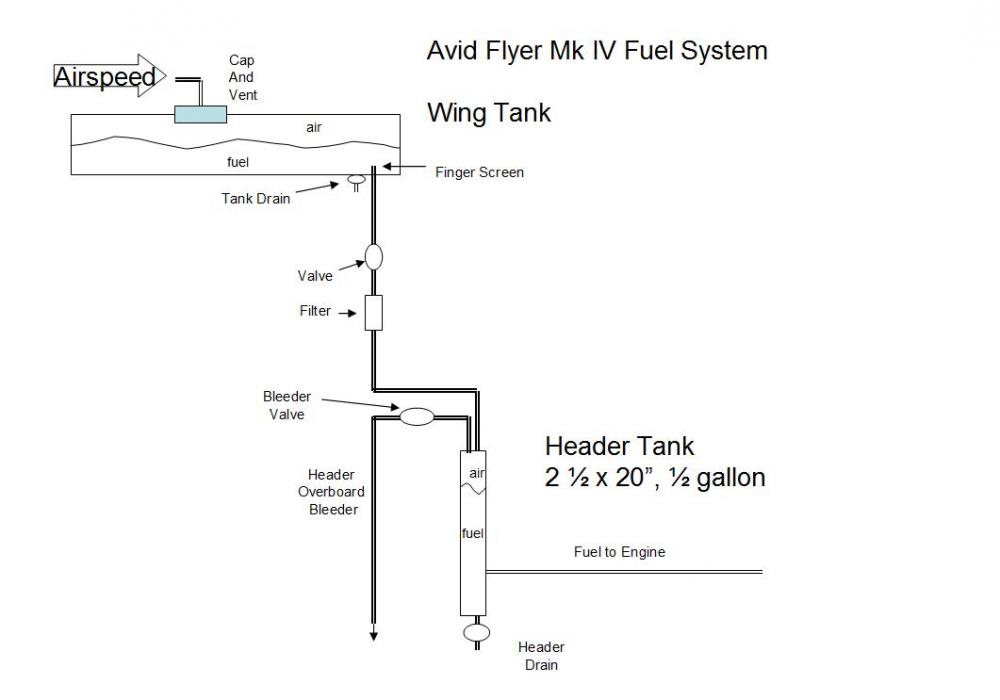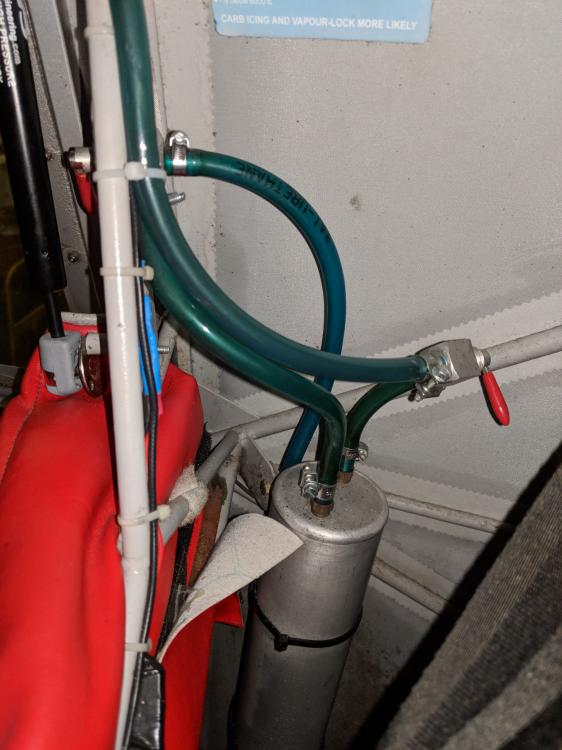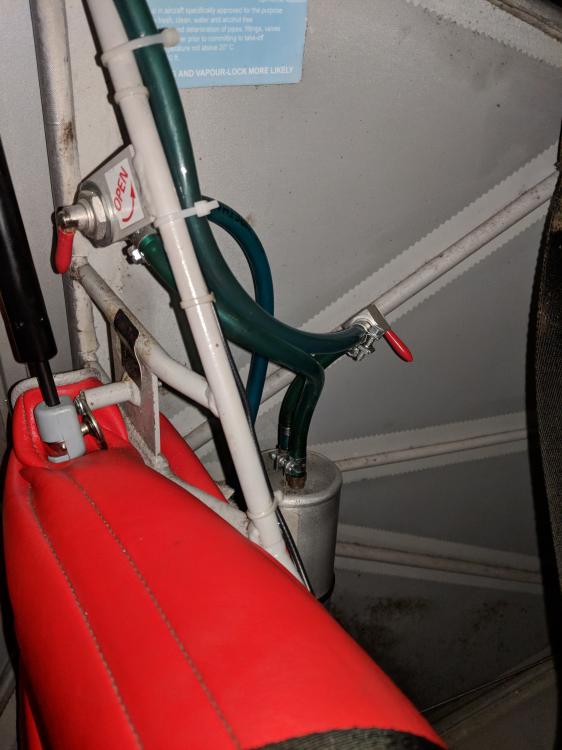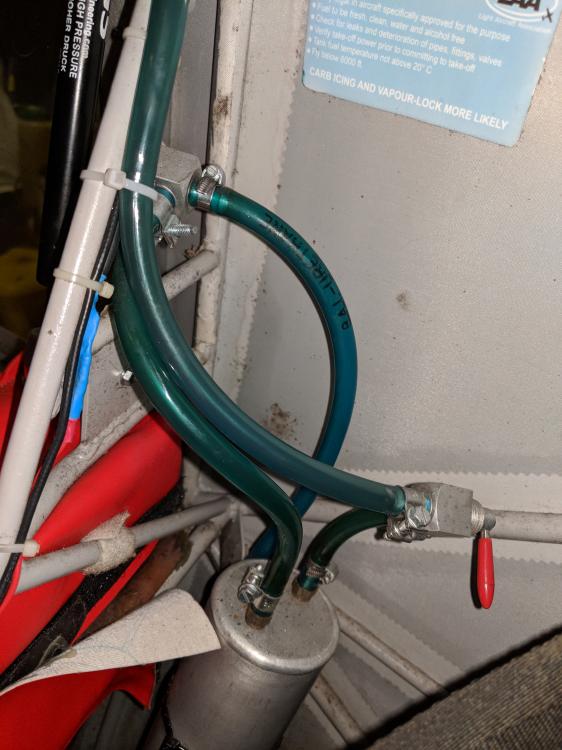-
Content count
50 -
Joined
-
Last visited
Posts posted by Gfry
-
-
When you find out let me know. I am thinking about converting mine from a 582 to a 912.
-
right....so I found a perfect fit from a tractor parts supplier in the UK. and it was mega cheap at £6.50.....about $8. a bit of 1/4 inch copper fuel pipe and a drill bit and it was soon modified with a vent tube.
2 people like this -
Interesting that with regards to yaw axis you say it flies straight hands off.....yes yes I know your feet are not hands but I assume you mean feet off as well? I find it interesting as you don't appear to have a rudder trim tab.
My MkIV has a rudder trim tab that is almost 90 degrees bent over!! and still requires a bit of boot to fly straight.
-
Mikuni pump overhauled today. It hasn't made a massive difference, its at least now a constant pressure and not flickering. At 2500rpm it's 0.3 bar and full power is a tiny bit over 0.2bar.
-
Never leave the vent open as it pisses fuel everywhere once it has finished venting.............
1 person likes this -
So finally got round to some ground runs yesterday (after finding a new fuel cap). I think the Mikuni pulse pump contributed to the failure. Turns out at idle the fuel pressure was right on 0.2 bar and at full power was flickering just below 0.2 bar. With the Facet pump on pressure was up at 0.4 nearly 0.5 bar. So as soon as I switched off the facet pump and at full power the Mikuni was not enough to deal with fuel venting back out over the wing. Doesn't explain why switching the facet back on did not restore flow though.
-
Fred,
I think the header tank was drained by the engine, which quit when the header was empty. The header was not refilling, because the pressure difference (suction) from the main side was too great.
I drew up a simple sketch of the single tank Avid system
I'm sorry to say but I think you are wrong and the reason is that there is no way the header tank could have been drained.
On your drawing (correct according the Gfry and his photos) we should assume that the bleeder valve, going out under the belly, was closed during the flight. Another given is an unknown amount of air in the header tank as shown in your drawing.
We now need to find a way to remove the fuel from the header tank and replace it with air... Where do we get that air from?
Not from the bleeder valve because it is closed.
Not from the main tank as it is still far from empty.
Not from the engine side as there is where we are pulling out the fuel.
With lower pressure the same amount of air take more volume but not enough to empty (fill?) the tank unless it was almost empty of fuel from the beginning. It is more likely that it was almost full of fuel. The lable with the arrow and "open" (on the photo) tend to indicate that purging is a part of the pre flight.In Gfry's last coment he "admits" that he started to drain the header tank with the valve between main and header closed. This is likely to gurgle and bubble and giving the impression the header tank is filing up while it in reality is air comming up through the purge valve.
The header tank was never empty - it could not have been...I think the explanation is that as long as the pump was running it countered the negative pressure in the main tank and successfully sucked/pulled fuel through the system. The moment the pump was turned off, the flow was inversed and air came, from the carburetor, to the pump and further. Air in the pump prevented restart of the flow.
(This flow of air through the system would not have altered the volume of fuel in the headertank, the air would have been sucked through the fuel still in the headertank before it continued thrught the line up to the main tank and freedom...)Makes sense to me
-
FredStork that is exactly right.
Maybe you had closed the valve between the main tank and the header tank after your exciting landing, "just in case"... If so, and if it remained closed when you started to purge the fuel before folding the wings, there could be a lot of gurgling and bubbling when air goes up through the purge and fuel goes down, and so with very limited flow in the beginning... This could give the impression of the header tank filling up...I think that's it. I shut everything off before exiting he aircraft.
-
FredStork that is exactly right.
-
-
Yep fuel pump was the first thing I went for.....
1 person likes this -
ok, I have 1 tank. I have a stop cock between the main tank and the header and I have a bleed valve to drain the header which is what I assume you are all calling a vent? part of my pre-flight is to bleed/vent the header for 10 seconds or longer if it needs to clear air. Once I was back on the ground and prior to loading on to the trailer I needed to drain what was in the tank as it was sloshing out the wing when they were folded. So I stuck a jerry can under the header tank and opened the bleed/vent valve.......it to quiet a while gurgling and bubbling and filling up before it started to bleed out the bottom.
Oh and I also have a fuel stop cock between the header tank and engine...roughly where the flapperon lever is.
1 person likes this -
I did switch it on as soon as it started to splutter. However it seemed useless as when I checked the header tank back on the ground it was bone dry. My guess is the fuel venting backwards then created an airlock in the header tank.
-
Few comments on a fuel pump. I do have a Facet fuel pump. Funny enough I just reached 1000 feet and switched it off, it was then that the engine died..... within seconds.
-
Does anyone know where I can get a fuel/gas cap for my Avid?
-
MKIV Speedwing
-
Well I survived my first engine failure yesterday…. not quite EFATO. I departed Charlton Park at 14:15 and about 1000 feet QFE the engine spluttered, I made a 180 turn and by the time I finished the turn the engine died at 14:17. Pitch for 65mph put out a MAYDAY to all stations on Kemble’s frequency. Now you would think an Avid Speedwing (bit like a kitfox) would glide lovely…… Wrong. To maintain 65mph was 1200 foot a minute decent.
There was absolutely no way of making it back to Charlton Park. I had to pick a field. The problem is all the fields had either telephone cables or power cable across them…apart from two, and they stretched the glide. So now I was about 600 feet and things up to that point seemed slow motion. After 600 feet everything happened so fast. It became clear the field I wanted was no longer possible and the only field now available was about 200 meters long, dome shaped, ridge and furrow very long grass and hemmed in by 8-foot hedges and a scattering of trees with a house in it.
I clipped a hedge, but other than that was down safe and stopped slap bang in the middle of the field. At 14:20 I got out the plane and called Kemble on the landline to let them know I was safe with no damage to property or the aircraft.
Now I remember that after the initial MAYDAY a helicopter said they were in the area and would head over to find me. I then gave a running commentary over the radio of what was going on until I was at 600foot. My last comment was I will call on the landline if I made it safe. Thing that got me is initially how slow everything seemed to go and then speed of event after 600 feet. All that was going through my head was “find a field” and “pitch for speed” over and over again, all the way until touch down.
At about 100 foot I did not think I was going to make it and thought I was going in to the trees and hedges, when I clipped the hedges there was the field with a steep upwards slope right in front of me. I yanked back on the stick immediately which gave the softest of touchdowns I think I ever done!!
What did I not do, I never switched anything at all, No fuel, no electrics, nothing. I don’t think I panicked, although I am sure my MAYDAY probably sounded a bit excited. A few mins after calling Kemble on the phone I felt really really sick and that passed after about 10 mins.
What would I do different if it happened again? I am not sure I would/could do anything different to be honest.
Ah yes what caused the failure. I am not sure yet, but the fuel cap had come off at some point in the take off. The wing was covered in fuel, but the tank was not empty by any means. So, I kind of hope that it was something to do with pressure and the fuel venting out the wing instead of getting to the engine. Now don’t shoot me for not checking the fuel cap as a pre-flight check…because I did. The fuel cap is an old vintage style cap like that of a cub or old car. How it came off is a mystery to me.
I survived, property survived and the aircraft survived with a tiny hedge rash. Would be intrigued to hear comments and questions.
Hedge Rash: 1 person likes this
1 person likes this -
Hi All,
So whenever you talk about clear doors, everyone says Lexan. Lexan is just a brand of polycarb and pretty cheap as well. However Margard is part of the Lexan product line which is a lot more expensive and much more scratch resistance. Surely a more scratch resistant product would be better?
Has anyone here any experience with using Margard instead of standard Lexan?
-
Yes it does have the tail wheel horns on the rudder. In general fly's really well. Few niggles like the flaperons are not rigged quiet right and the prop pitch is slightly off.....both jobs that I am working on tomorrow (20th March). AOA was wonky on the port wing so winding out the rear strut by 720 degrees solved that one.
-
Sure did buy Simons. Few little niggles to sort out, but in general a mega bargain. Would be interested in any Avid parts you have.
-
Hi All,
I am looking for door latches and handles for my Avid MK IV. Currently it only has a handle on the port side door which is from a house door! and the latches on both sides are worn and barley catch.
I am in the UK, but happy to pay for international shipping.
-
Forgive my ignorance of the Mark IV, but couldn't you reuse the main gear by moving up to the next set of attach points and perhaps swapping sides? There are better alternatives than the bungee gear, but none cheaper than using what you have already.
Possibly. Still need a tail wheel.
-
On your doors, like akflyer said, I redid mine to, just temoved the old panels, drilled out the rivetshttp://creativemetalmontana.com/examples.htm, straightened the frames to fit better, then made a pattern of the door frame out of cardboard and cut 1/8" Lexan to fit leaveing adout a quarter inch to trim at the end, use the same rivet holes in your frame or weld them shut and drill new ones. My plastic hangs over the frame about an inch for rubber to seal it against the body.
I take it you did not form the slight bulge in the lexan that you used? If you did, how did you do it?
-
You can look a grove for the main gear:
http://www.groveaircraft.com/landing_gear.html#avid
The stock tailwheel setup is a bit twitchy. The grove gear is wider, which improves that. There are other threads on different main gear here as well.
Lots of threads here on tail wheel options.
If you do the conversion, I want first dibs on the gear you take off! :-)
Mark
Tell you what, lets go halves on a taildragger kit and you can have all the nose pusher stuff of my aircraft....I will pay the shipping.





New Rotax 670 Install
in Rotax and other engines
Posted
I wonder what hoops I would have to jump for a 670 in the UK.......